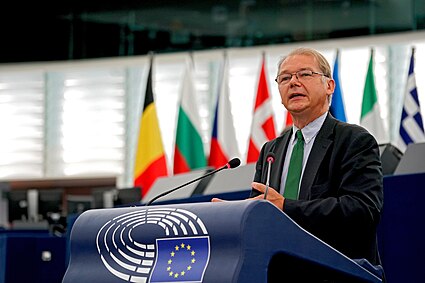A | B | C | D | E | F | G | H | CH | I | J | K | L | M | N | O | P | Q | R | S | T | U | V | W | X | Y | Z | 0 | 1 | 2 | 3 | 4 | 5 | 6 | 7 | 8 | 9
| ||||||||||||||||||||||||||||||||||||||||||||||||||||||||||||||||||||||
All 720 seats to the European Parliament 361 seats needed for a majority | ||||||||||||||||||||||||||||||||||||||||||||||||||||||||||||||||||||||
|---|---|---|---|---|---|---|---|---|---|---|---|---|---|---|---|---|---|---|---|---|---|---|---|---|---|---|---|---|---|---|---|---|---|---|---|---|---|---|---|---|---|---|---|---|---|---|---|---|---|---|---|---|---|---|---|---|---|---|---|---|---|---|---|---|---|---|---|---|---|---|
| ||||||||||||||||||||||||||||||||||||||||||||||||||||||||||||||||||||||
| ||||||||||||||||||||||||||||||||||||||||||||||||||||||||||||||||||||||
The 2024 European Parliament election is scheduled to be held on 6 to 9 June 2024.[1] This will be the tenth parliamentary election since the first direct elections in 1979, and the first European Parliament election after Brexit.[2][3]
Overview
This term's election is expected to be one of the more contentious elections in the history of the European Parliament given the rise of far right parties in polling.[4][5] The EPP in particular has raised eyebrows given its efforts to charm parties in the ECR to create a broad conservative block[6] that could upset the long standing balance which has seen the EPP share power with the center-left S&D and the centrist Renew Group.[7]
Electoral system
Attempts at electoral reform
In June 2018, the Council agreed to change the EU electoral law and to reform old laws from the 1976 Electoral Act as amended in 2002.[8] New provisions included a mandatory 2% threshold for countries with more than 35 seats and rules to prevent voters from voting in multiple countries.[9] After the Act was adopted by the Council following consent given by the European Parliament in July 2018, not all member states ratified the Act prior to the 2019 elections, which took place under the old rules. As of 2023, the reform has yet to be ratified by Cyprus and Spain;[10] Germany only ratified in summer 2023.[11]
On 3 May 2022, the European Parliament voted to propose a new electoral law, which would contain provisions for electing 28 seats on transnational lists.[12] As of 2023, this reform has not been approved by the Council, which must approve it unanimously.[13]
Spitzenkandidat system
In the run-up to the 2014 European Parliament elections a new informal system was unveiled for the selection of the European Commission President dictating that whichever party group gained the most seats would see their lead candidate become President of the Commission.[14] In 2014, the candidate of the largest group, Jean-Claude Juncker, was eventually nominated and elected as Commission President.[15] European party leaders aimed to reintroduce the system in 2019, with them selecting lead candidates and organizing a televised debate between those candidates.[16] In the aftermath of the election German Defense Minister Ursula von der Leyen was chosen as Commission President, even though she had not been a candidate prior to the election, while Manfred Weber, lead candidate for the EPP, which had gained the most seats, was not nominated.[17] Following the non-application of the system in 2019, some have called for the system to be revived, in the upcoming elections.[18][19][20]
As of 2023, the EPP[21] EGP,[22] and PEL[23] have announced their intensions to nominate a main candidate in 2024, while ECR and ID have rejected doing so.[24]
Apportionment
As a result of Brexit, 27 seats from the British delegation were distributed to other countries in January 2020 (those elected in 2019, but not yet seated took their seats).[25] The other 46 seats were abolished with the total number of MEPs decreasing from 751 to 705 after that.[26]
A report in the European Parliament proposed in February 2023 and passed in June 2023 to modify the apportionment in the European Parliament and increase the number of MEPs again in order to adapt to the development of the population and preserve degressive proportionality.[27][28] The European Council will, by unanimity, take the final decision on the size of the European Parliament and each national seat quota. On 26 July 2023, the Council reached a preliminary agreement, which would increase the size of the European Parliament to 720 seats.[29] On 13 September 2023, the European Parliament consented to this decision,[30] which was adopted by the European Council on 22 September 2023.[31]
Electoral system by country
| Member state | Seats | Date | Voting age | Compulsory voting | Absentee voting | Age of candidacy | Constituencies | Threshold | Electoral system[32] | Candidate selection[32] |
|---|---|---|---|---|---|---|---|---|---|---|
| 20(+1) | TBD | 16 | No | By post | 18 | 1 | 4% | D'Hondt | Semi-open list | |
| 22(+1) | 16[33] | Yes | By post and by proxy | 21 | 3 | 5% | D'Hondt | Semi-open list | ||
| 17 | 18 | No | — | 21 | 1 | ~5.9%[a] | Largest remainder[b] | Semi-open list | ||
| 12 | 18 | No | — | 18 | 1 | 5% | D'Hondt | Semi-open list | ||
| 6 | 18 | Yes | — | 21 | 1 | 1.8% | Largest remainder[b] | Open list | ||
| 21 | 7–8 June[34] | 18 | No | — | 21 | 1 | 5% | D'Hondt | Semi-open list | |
| 15(+1) | 9 June[35] | 18 | No | By post | 18 | 1 | — | D'Hondt[c] | Open list | |
| 7 | 9 June[36] | 18 | No | By post and online | 21 | 1 | — | D'Hondt | Open list | |
| 15(+1) | 9 June[37] | 18 | No | By post | 18 | 1 | — | D'Hondt | Open list | |
| 81(+2) | 9 June[38] | 18 | No | By proxy | 18 | 1 | 5% | D'Hondt | Closed list |











